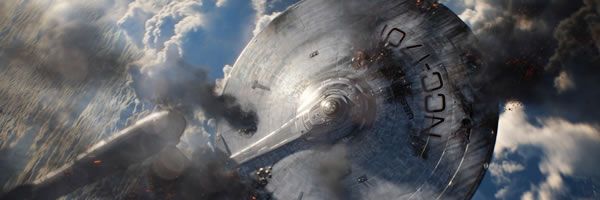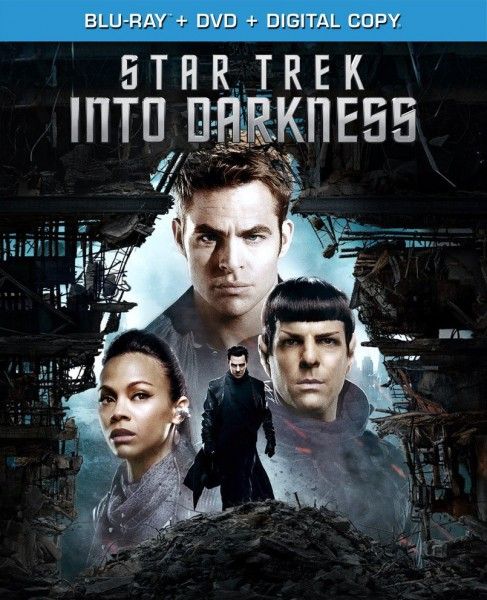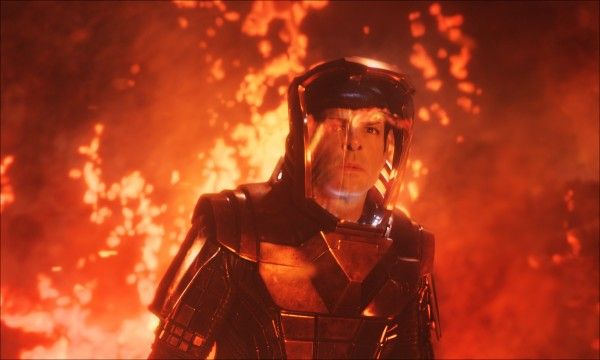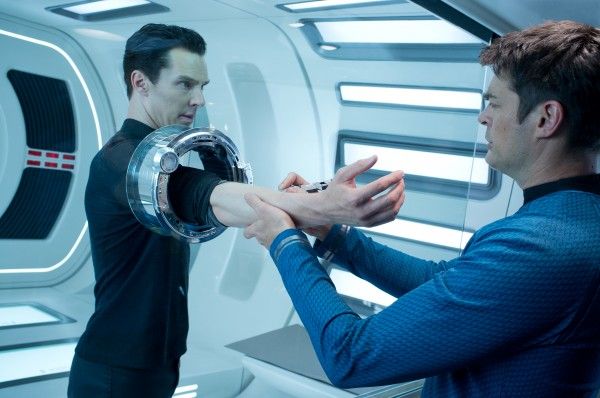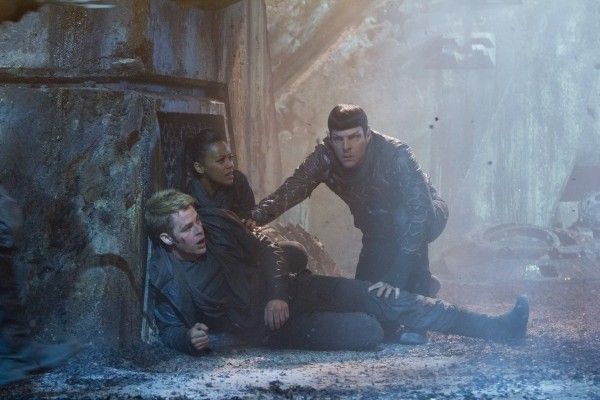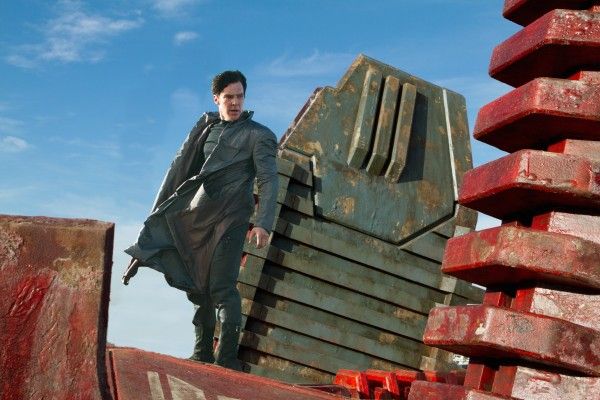When Star Trek Into Darkness came out it got a 87% approval rating on Rotten Tomatoes, and was generally well received on the road to making over two hundred million dollars domestically, and nearly half a billion worldwide. At a recent Star Trek convention, it was ranked the worst Trek movie, which means some fans think it’s worse than Star Trek: Nemesis or Star Trek V: The Final Frontier. Now that it’s on home video, perhaps there’s a more rational approach to the film, which stars Chris Pine, Zachary Quinto, Simon Pegg and Benedict Cumberbatch. My review of Star Trek Into Darkness follows after the jump.
Here’s the thing about the film: If you’re not a fan of Star Trek, of its ideals and the semi-science that was incorporated into the shows and movies (movies less so), STID is simply another big budget Hollywood summer action movie, which means it has a lot of thrilling set pieces, and it wobbles (as most do most blockbusters these days) in the final stretch, but other than an exposition dump halfway through the movie, it delivers a lot of exciting set pieces, and is no more dumb than Iron Man or Man of Steel or any of the other high profile CGI-laden action movies of late.
But for fans of the original show, trouble is apparent from the first sequence where the Enterprise is shown under water while investigating an M-class planet that has never seen or experienced extra-terrestrials before. Why would you hide a space vessel under water, especially when it seems to work against the mission? Though it’s possible there was an explanation at some point, that their atmosphere is such that any orbital would be visible during the daylight, or some such thing, it seems the real answer is that it would look cool for the Enterprise to emerge from water. And it’s a striking shot, but it speaks to how this is the “Cool” version of Star Trek. And it is cool, but it’s also the dumbed down version of Trek.
The film begins with the crew investigating a planet where a volcano is about to erupt. Spock (Quinto) is trying to plant a cold fusion device (again, the science of this film is lacking as that’s not what a cold fusion device would do) in an active volcano, and so James Kirk (Pine) breaks the prime directive to rescue his friend, which Spock constantly cites but seems to be breaking in his actions. Spock, naturally, reports the incident which costs Kirk his captain’s chair. So this leads to Admiral Pike (Bruce Greenwood) basically repeating the scene from the first film where he says he believes in Kirk and makes Kirk his first officer. But there’s a terrorist loose named John Harrison (Cumberbatch) who destroys a Star Fleet building, which brings together the heads of the organization. Kirk realizes as the meeting is happening that the location of their pow-wow might be known to Harrison, but it’s too late to stop Harrison from shooting up a number of high command officers. This incident reinstates Kirk to the captain’s seat, and he’s sent on a mission to a Klingon planet to kill Star Fleet enemy number one.
The mission is clandestine, and the Klingons are on the brink of war with Star Fleet, so Kirk is supposed to tread carefully, but the mission seems odd, especially when the Enterprise is outfitted with 72 new torpedoes. Scotty (Pegg) objects so he resigns his command in protest, and Chekov (Anton Yelchin) is put in charge of engineering. Once they arrive near Kronos, the planet on which Harrison is hiding, the warp core goes out. Kirk decides to follow Spock’s advice and take Harrison alive, but that leads to their shuttle being spotted by the Klingons. Harrison rescues Kirk and company from the Klingons and allows himself to be captured, but – if you’ve seen some recent movies – you can tell that he’s down with being caught. It turns out there’s something much worse happening than just Harrison.
Okay, that’s the bones of the plot, and to go further will involve spoilers. Get ready to enter spoiler territory: Harrison is Khan, and Admiral Marcus (Peter Weller) is trying to start a war with the Klingons because he feels that it’s inevitable.
Fans are going to be annoyed with the decision to incorporate Khan into the film, especially since the film borrows heavily from Star Trek II: The Wrath of Khan. The biggest problem with this is that when Cumberbatch reveals himself as Khan it means nothing to Kirk or Spock because this comes before the episode that introduced Khan to the universe (“Space Seed”). It’s for the audience who may or may not know his history. But because the crew don’t know who he is it’s like the scene was “My real name is Adolph Hitler…. What you don’t know about me is that I was born in Germany…” The reveal ultimately leads to a gigantic info dump on screen, and there’s nothing anyone can do to make it all that interesting. But then the film kicks back into gear as the film does something interesting in teaming Kirk and Khan. And the moments where the film comes most alive is when it messes with canon.
Director J.J. Abrams and writers Damon Lindeloff, Roberto Orci and Alex Kurtzman know they’ve got fans who are going to complain about whatever they do, so in some ways Khan was their Kobayashi Maru. It makes sense to get Khan out of the way, but there was no way they could have the weight of STII in that it was about old opponents meeting each other years later and the anger that Khan had for Kirk. The original episode is a solid entry in the Trek canon, but it’s not a top five episode. Where Wrath of Khan is inarguably the best Trek movie because it uses the fact that the characters are older, and facing death in a way that could only come from those actors inhabiting these roles for over fifteen years. You can’t fake that weight.
Another big decision is that they’ve given the bulk of the Leonard ”Bones” McCoy role (played here by Karl Urban) to Scotty. He’s the heart of the ship, and if Spock represents pure intellect/super ego and Kirk the balance, Scotty has become the id. It works well because Pegg is so much fun in the role, but it also leaves Bones with less to do in this film than the first film. But that may be why his best scene is another moment where they mess with canon when McCoy seems to hit it off with Carol Marcus (Alice Eve).
It would be easy to list off the things that have been complained about (how Alice Eve is shown in her underwear, how transporters do and do not work, etc.), which are mostly valid and it’s hard to ignore the film’s use of the events of September 11 -- and the resulting Iraq war -- as a sticking point with the movie, but using terrorist attacks to provoke a stupid response from a government and 9/11 itself has also become a cliché in big budget movies, ranging in this year alone from G.I. Joe Retaliation to Man of Steel. And where the first film was fun and light and airy and all that worked for the film, because of the darker subject matter here, it’s not the same fun ride (the filmmakers seem to know this so they pay lip service to Kirk the playboy, and give nods to canon elements like Nurse Chapel and Harry Mudd). If the first film was getting tipsy and flirting and going home with a phone number, the second film is getting tipsy and stuck at a table with a drunk and going home with a hangover.
If there’s a big problem with the movie it’s that it’s too packed. It’s like the film has just to jam so much in to the story that it sort of flat-lines after a while, because nothing has much weight. There’s a moment where Kirk and Spock meet Scotty and they run up to him. This is the movie in a nutshell. Why are they running? Because it’s more exciting than walking. But then… why? Kirk loses his command, and that seems like a big deal, but less than twenty minutes later he’s reinstated.
And, big spoiler, Kirk dies, but less than twenty minutes later, he’s alive again. Which ties into one of the film’s biggest problems for fans: recreating the final section of Khan (even with the roles reversed) was a no win decision. There is an idea there that shows Kirk and Spock have learned from each other, but the biggest problems is that at that point in the movie, Kirk is the main protagonist, and turning Spock into the lead for the final action set piece ultimately works against the film because even though the film sets up that Spock needs to embrace his human side a little more, there’s a reason he doesn’t. The weight of the narrative is on Kirk, he needs to grow up and accept sacrifice (which seems a little too much like the narrative of the first film), so when you get another ten minutes of action after he’s shown he’s a true leader, it not only robs his moment of its power (especially with Quinto yelling “Khaaaaaan!”), you’re thrust back into another big action set piece. There is only the time of the death to care about it in screen time.
And this confusion of who should be the lead happens with the villains. Marcus and Khan are both the bad guys, but Marcus reveals himself to be -- in the words of the writers -- “the big bad,” but then he’s taken care of, and Khan takes over, but then Khan is defeated, but that’s not enough so there’s got to be another big action sequence that revolves around a footchase and a pursuit that reminds of the speeder chase in Attack of the Clones. The end is determined by punching, which is the least Star Trek idea ever. But for those who don’t care, watching Spock and Khan get into fist fights (note: every member of the Trek crew has the most amazing upper body strength as they’re often able to hoist hundreds of pounds with one arm, though that’s an acceptable action movie cliché) might be just the sort of personal fight they need, rather than see Spock use his intellect to defeat his enemy. For fans of the original, had Spock won by fooling Khan, the film might be easier to stomach. It would also avoid having Khan send his airplane into the World Trade Center, err… his space ship into Star Fleet headquarters.
There is fun to be had in this film, and lord knows it’s more watchable than every Next Generation film, which never knew how to deal with having so many lead characters (that’s a problem here too as Urban, Zoe Saldana’s Uhura, Yelchin and John Cho’s Sulu only get a big scene or two, but that’s often what the original series films did as well). But those Next Gen films can work for fans because they like the characters and the performers, here they may have a connection to the characters, but the new iterations aren’t exactly the same, so it’s not there’s. The fanbase was mostly on board with the reboot, but if the third film (which is being worked on right now) doesn’t right itself, it seems more than likely that fans will just pretend this Abrams version of Star Trek isn’t canon. Perhaps they should write it off entirely and leave this new Trek for the fans who could never get into the original in the first place. Regardless, they’re going to watch and possibly own these films anyway. In terms of the big summer movies, Star Trek Into Darkness is one of better tentpole releases, but that may say more about tentpole releases than Into Darkness.
Paramount’s Blu-ray also comes with a DVD and digital copy. The film is presented in widescreen (2.35:1) and in 7.1 Dolby TrueHD. This is definitely a demo disc as the picture and sound quality are reference quality. It’s a clean and beautiful disc with plenty of surround action and good atmosphere. The standard Blu-ray comes with seven featurettes. “Creating the Red Planet” (8 min.), “Attack on Starfleet” (5 min.) “The Klingon Home World” (8 min.), “The Enemy of My Enemy” (7 min.) “Ship to Ship” (6 min.) “Brawl by the Bay” (6 min.) and “Continuing the Mission” (2 min.). These walk through the major set pieces of the film, and spend time talking about Cumberbatch’s character in informative bit-sized chunks. There’s also a trailer for “The Mission Continues” which is for work done by army vets to make America a better place. If the extras seem weak, it’s because Paramount decided to divvy up some of the extras so there’s in store exclusive versions and the audio commentary is available at the iTunes store. Perhaps when the third film comes out all the supplements will be packaged together, but for die hard, it’s hard not to feel a bit ripped off by this release.

